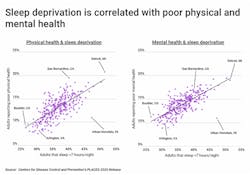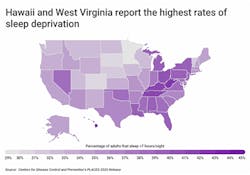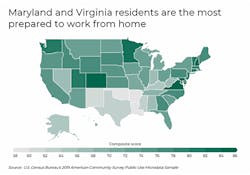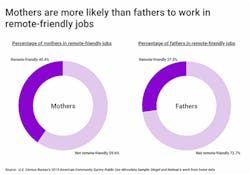Looking for a Change? Or Not?
Lots of info, lots to digest, and lots to choose from.
What follows are short summaries about a variety of reports about Working from Home (WFH), and the links to the complete reports.
The reports are:
THE BEST CITIES TO WORK FROM HOME
THE MOST AFFORDABLE CITIES TO SIZE UP FOR A HOME OFFICE
AMERICA’S MOST SLEEP-DEPRIVED CITIES
CITIES MOST PREPARED TO WORK FROM HOME
CITIES WITH THE MOST PARENTS WORKING FROM HOME
CITIES WITH THE MOST REMOTE FRIENDLY JOBS
THE MOST STRESSED-OUT CITIES IN AMERICA
Here are summaries of the reports and some graphics, and their links to the complete reports:
THE BEST CITIES TO WORK FROM HOME
While the COVID-19 pandemic has been devastating for many businesses and workers, it has led to greater flexibility for workers in some industries. Employees at major tech companies, including Twitter and Google for example, have been granted extended opportunities to work from home, sometimes permanently. These changes have afforded many people the ability to work and live where they want, rather than being bound to large cities where their employers have offices.
This shift is leading many workers toward "Zoom towns"—cities that are booming as remote work becomes more popular. While much of the U.S. is experiencing rising home values during the pandemic as a result of low inventory, areas experiencing the largest booms are these Zoom towns, which are increasingly attracting well-educated laptop workers with lower living costs, access to outdoor recreation, and strong (albeit less dense) communities. Unfortunately for many workers, the opportunity for remote work and the ability to relocate to these cities are often only available to workers in tech, financial services, sales, and other similar roles that can be performed remotely.
InvisiLight® Solution for Deploying Fiber
April 2, 2022Go to Market Faster. Speed up Network Deployment
April 2, 2022Episode 10: Fiber Optic Closure Specs Explained…
April 1, 2022Food for Thought from Our 2022 ICT Visionaries
April 1, 2022To find the best locations to work from home, researchers at RetailMeNot ranked cities and states based on several metrics related to 1) community and safety, 2) housing and living costs, and 3) health and weather.
Here are the 15 best cities for remote workers: Gilbert, Arizona; Cary, North Caroline; Frisco, Texas; Bellevue, Washington; Fremont, California; Carmel, Indiana; Thousand Oaks, California; Centennial, Colorado; Torrance, California; Olathe, Kansas; Henderson, Nevada; Carlsbad, California; Roseville, California; League City, Texas; and Sandy Springs, Georgia.
For more information, a detailed methodology, and complete results, you can find the original report on RetailMeNot’s website: https://www.retailmenot.com/blog/best-cities-to-work-from-home.html
THE MOST AFFORDABLE CITIES TO SIZE UP FOR A HOME OFFICE
A new study conducted by Filterbuy looks at the most affordable U.S. metropolitan areas to size up for a home office. As a result of the pandemic, more Americans are working from home than ever before, but not everyone has the extra space for a home office. On average, sizing up to an apartment with an additional bedroom costs about 9% of monthly income, but some locations are more affordable than others. Researchers ranked metros across the country according to the average cost to size up for an additional bedroom as a percentage of income.
One of the COVID-19 pandemic’s biggest impacts on the labor market has been the remarkable shift to working from home. While working from home is not new, the U.S. has never seen remote work at the current scale. A recent Gallup poll from the fall shows that a whopping 58% of U.S. workers were working remotely at least part of the time, yet many lacked sufficient space at home to do so effectively.
Having a dedicated home office can help remote workers be more productive, and sizing up to an apartment with space for a home office may be worthwhile for workers who plan to continue working remotely. However, depending on rent prices and income, renting a larger space is more affordable in some cities than others. According to income data on renters from the U.S. Census Bureau and rent prices from the Department of Housing and Urban Development (HUD), sizing up to an apartment with an additional bedroom costs about 9% of monthly income, on average.
An obvious advantage of working from home is not commuting, which saves valuable time and money. Data from HUD shows that commuters who drive the entire way to work spend a median of $242 each month on commuting costs. Carpoolers and those who take public transportation spend less—$132 monthly at the median—while those who drive part of the way (while also using another mode of transportation such as public transportation, walking, or cycling) spend the least at $110 per month. According to fair market rent data from HUD, the median monthly cost of an additional bedroom in the U.S. is $317, meaning upgrading to a larger apartment could be close to cost-neutral for workers in more affordable areas with long and expensive commutes.
For more information, a detailed methodology, and complete results, you can find the original report on Filterbuy’s website: https://filterbuy.com/resources/affordable-cities-for-home-office/
AMERICA’S MOST SLEEP-DEPRIVED CITIES
A new study from RetailMeNot looks at the most sleep-deprived cities in the United States. Sleep deprivation is associated with diabetes, cardiovascular disease, hypertension, obesity, and depression, among other health concerns. Researchers ranked cities according to the percentage of adults that usually sleep less than 7 hours per night, and included the percentage of adults in each location that report poor physical and poor mental health.
Despite the importance of good sleep, a large number of U.S. residents do not report getting the rest they need each night. The Centers for Disease Control and Prevention estimate that 70 million Americans experience insufficient sleep, defined as 7 hours or less each night. In 2013, the CDC declared that this level of sleeplessness constituted a public health epidemic.
Here are the most sleep-deprived large cities in the U.S.:
Detroit, Michigan; Cleveland, Ohio; Memphis, Tennessee; Philadelphia, Pennsylvania; Baltimore, Maryland; Columbus, Ohio; New York, New York; Jacksonville, Florida; Miami, Florida; Oklahoma City, Oklahoma; Louisville, Kentucky; Nashville, Tennessee; Milwaukee, Wisconsin; Houston, Texas; and Las Vegas, Nevada.
For more information, a detailed methodology, and complete results, you can find the original report on RetailMeNot’s website: https://www.retailmenot.com/blog/most-sleep-deprived-cities-in-america.html
CITIES MOST PREPARED TO WORK FROM HOME
A new study from Filterbuy looks at the locations in the U.S. that are most prepared to work from home. In addition to having the hardware and Internet access in order to work remotely, having a suitable home workspace is associated with increased telework satisfaction and self-reported productivity. Researchers ranked metropolitan areas according to a composite score that was generated by looking at a variety of factors, including the percentage of workers in remote-friendly jobs, the percentage of households with computer access and broadband Internet, and the percentage of households with a spare bedroom that could be used as a home office.
To find the most prepared places in the U.S. to work from home, researchers at Filterbuy analyzed data from the U.S. Census Bureau and the University of Chicago.
They created a composite telework preparedness score based on the following factors:
• Percentage of workers in remote-friendly jobs
• Percentage of households with a laptop or desktop computer
• Percentage of households with broadband Internet, such as cable, fiber optic or DSL
• Percentage of households with at least one spare bedroom that could be used as a home office
• Median number of rooms per person in each household
At the state level, many of the most-prepared states to work from home are on the East Coast. The two states flanking Washington, D.C., Maryland and Virginia, rank the highest in the country according to the composite score.
The South tends to be less prepared to work from home. Arkansas ranks the lowest in the country according to its composite score. Just 26% of jobs in Arkansas can be performed from home, while less than two-thirds of Arkansas households own computers. Only 56% of Arkansas households have high-speed Internet.
A summary of the analysis, and the link to the original report, which includes a table with data on more than 250 metros and all 50 states: https://filterbuy.com/resources/cities-most-prepared-to-work-from-home/
CITIES WITH THE MOST PARENTS WORKING FROM HOME
A new report by RetailMeNot looks at the U.S. cities with the most parents who work from home. Due to differences in local economies, there is significant variation in the share of jobs that can be performed at home across the country. For those who are working from home with kids, it can be difficult to balance work with family responsibilities. Researchers ranked metro areas according to the percentage of working parents in remote-friendly jobs and included the percentage of both working fathers and mothers in remote-friendly jobs.
InvisiLight® Solution for Deploying Fiber
April 2, 2022Go to Market Faster. Speed up Network Deployment
April 2, 2022Episode 10: Fiber Optic Closure Specs Explained…
April 1, 2022Food for Thought from Our 2022 ICT Visionaries
April 1, 2022The COVID-19 pandemic has resulted in a major shift towards remote work. While working from home has its benefits for certain individuals, including no commute time, a better work-life balance, and increased productivity, it can be hard for parents—especially mothers—to work from home while juggling family responsibilities. Additionally, not all occupations are conducive to remote work. A recent study by University of Chicago researchers shows that 37% of jobs in the U.S. are able to be performed entirely at home, but this varies substantially across cities. When considering working parents, Census Bureau data combined with data from the aforementioned study show that about 34% hold remote-friendly jobs.
According to occupational data from the U.S. Census Bureau, working mothers are more likely than working fathers to work in remote-friendly jobs. Over 40% of working mothers work in remote-friendly jobs compared to just 27% of working fathers. However, several studies show that working from home is harder for moms than it is for dads. As schools and day care centers closed during the pandemic, the gender gap in household chores and child care has widened. Research indicates that women working from home are more likely to take on a disproportionate share of housework and child care, while men are more likely to report an increase in productivity.
Due to differences in local economies, there is significant variation in the share of jobs that can be performed at home across cities and states. For instance, places that rely heavily on agriculture, manufacturing, retail, and hospitality tend to have fewer jobs that can be performed at home, while areas with more business and professional jobs tend to have a large share of jobs that can be done remotely. At the state level, the Northeast tends to have more working parents in remote-friendly jobs with New Jersey and New Hampshire boasting the highest shares at 40.1 and 38.6%, respectively. At the opposite end of the spectrum, North Dakota and Nevada have the lowest shares of working parents in remote-friendly jobs, at 27.4 and 25.9%, respectively.
For more information, a detailed methodology, and complete results, you can find the original report on RetailMeNot’s website: https://www.retailmenot.com/blog/cities-with-most-parents-working-from-home.html
CITIES WITH THE MOST REMOTE FRIENDLY JOBS
A new report from Outdoorsy looks at the long-term capacity for remote work across the United States. COVID-19 has caused millions to work from home, and many may wonder whether remote work will continue after the virus is contained. The report found that just over one third of all U.S. jobs could be carried out remotely and ranked metro areas according to the percentage of workers in remote-friendly jobs. The analysis also includes educational attainment and race/ethnicity data for each location.
In a nationwide effort to slow the spread of COVID-19, millions of Americans have transitioned to remote work. An impending vaccine may leave many wondering whether the influx of remote work will recede with the virus. Some companies have already committed to remote working conditions beyond 2020—even permanently—but there are several jobs that simply cannot be carried out from home. Those who work in maintenance, food preparation, construction, and much of the healthcare industry are often (or always) required to physically be somewhere other than home.
As it turns out, educational attainment is a strong predictor of the ability to work remote. Citing responses provided in the annual American Time Use Survey (ATUS), the BLS discovered that the percentage of workers who could do at least some work from home on an average day increases significantly based on educational attainment. While less than 5% of workers who did not finish high school report being capable of doing some work from home, more than 50% of those with a bachelor’s degree or higher could.
Educational attainment is not the only predictive measure of remote work. The ATUS found that certain minorities were disproportionately underrepresented in the potential remote workforce. Overall, only 16.2% of Hispanic or Latino workers and 19.7% of Black or African American workers report being able to do some of their work from home compared to 29.9% and 37% of White and Asian workers, respectively. In addition to occupation, living arrangements—including access to computers and broadband Internet—may impact the ability of many minorities to work remotely. Pew research found that prior to the pandemic, only 57% of Hispanics and 58% of Blacks had access to a computer at home compared to 82% of Whites.
The ability to work from home has not only kept millions of Americans employed this year, but remote work is also financially rewarding. While remote jobs make up 35.5% of all U.S. employment, they account for 45.8% of all U.S. wages. As a result, locations throughout the country with higher percentages of workers in remote-friendly occupations report generally higher median annual wages.
A summary of the analysis, and the link to the original report, which includes a table with data on more than 350 metros and all 50 states: https://www.outdoorsy.com/blog/top-remote-friendly-cities
THE MOST STRESSED-OUT CITIES IN AMERICA
A new report from RetailMeNot looks at the most and least stressed-out cities in America. Chronic stress disturbs the immune, digestive, cardiovascular, sleep, and reproductive systems and increases susceptibility to serious conditions like heart disease and diabetes. Worldwide polling finds that Americans express feelings of stress, worry, and anger more frequently than populations in almost every other country. Researchers examined a variety of metrics — including mental and physical health, housing costs, poverty rates, and the percentage of the population with health insurance, among other factors — to generate a stress score for each U.S. city.
A summary of the analysis, and the link to the original report, which includes a table with data on more than 300 cities and all 50 states: https://www.retailmenot.com/blog/most-stressed-out-cities-in-america.html











